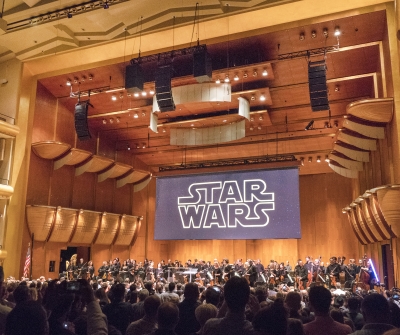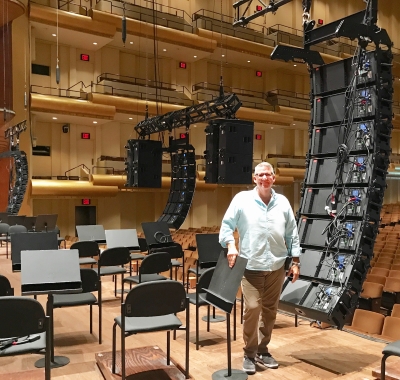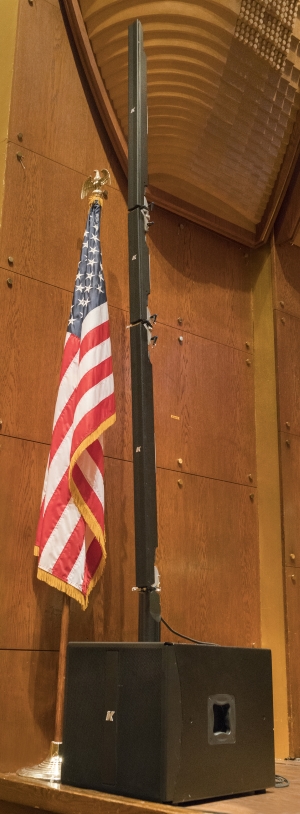Designing the sound and mixing the recent New York Philharmonic presentation of four Star Wars films – A New Hope, The Empire Strikes Back, Return of the Jedi, and The Force Awakens – at Lincoln Center in Manhattan stands as one of the most challenging projects in the four-decade professional audio career of Lou Mannarino.
Given the work he’s done with A-list artists, at numerous high profile venues, and in 11 years with the NYP itself, that’s saying something, but he stands by that assessment. The performances, presented in surround at 2,700-seat David Geffen Hall, consisted of the film screenings accompanied by John Williams’ iconic score performed live by the 100-plus piece orchestra conducted by David Newman.
“When the project came into being in spring 2017, I worked with Disney and Epilogue Media, and I studied the films,” Mannarino says. “I knew them, as everybody does,” while also noting that a performance of this nature, with these films, hasn’t been mounted before. “For the dialogue, sound FX and source music, I got the original studio breakout for the sounds – all of it time coded – but the orchestra was live the entire time.”

One of the biggest tests was making the concert hall feel more like a movie house; ensuring the dialogue was clear, the effects physically palpable, and that the orchestra was able to successfully perform the soundtrack without “blowing people out of their seats.”
To do so he created what he describes as a “7.1 reinforcement system times four, because the hall has four tiers” – a solution that provided full coverage throughout the while preserving each film’s complex sonic imagery.
Putting It Together
Among the aspects of the sound design requiring a great deal of consideration and planning were an orchestra clocking in at about 92-plus dB, the necessity of placing surround elements (as well as subwoofers) in close proximity to audience members, and maintaining sonic imagery in locations presenting far greater challenges than the average movie theater.
After receiving a list of stems (recorded tracks from the films), and deciding where other various audio elements – live and recorded – needed to come from, he began mocking up designs and testing various systems in his production facility.
Ultimately Mannarino assembled a main PA comprised of K-array loudspeakers joined by models from his own company (L&M Sound & Light, Staten Island) and the venue’s permanently installed d&b audiotechnik loudspeakers. “I tried many different speaker configurations, and K-array, because it’s digitally steerable, proved a key to coverage.”
The main system center cluster consisted of six K-array Mugello KH2 active line array elements flown at the center of the stage proscenium and flanked by a d&b cardioid subwoofer on each side. Pre-existing proscenium-mounted d&b compact loudspeakers delivered fill to the upper seating tiers, driven by d&b 30D four-channel amplifiers.
Left, center and right (LCR) main arrays, also flown at the proscenium, were also comprised of KH2s, each with seven elements. “The KH2 features slim array technology, which provides a fast transient response, as well as less side noise pollution, it allowed me to put something in front of people without adding to the reverberant space of the hall,” he explains. “I was also able to digitally steer output from the arrays – open them up at the bottom and not so much at the top – to keep the coverage even, so the middle and back of the hall sound the same as the front.”

Eight LM4 compact full-range loudspeakers were deployed along the front edge of the stage as fills, with power and DSP provided by a QSC PLD4.2 amplifier. For rear surround, Mannarino chose a dozen K-array Pinnacle KR102s, designed to provide line array performance characteristics from a very slim column package.
Specifically, three KR102s were deployed per seating level, placed left, center and right, joined by companion subs and a satellite array for emphasis on higher frequency content. “I utilized these mini line arrays for surrounds because, unlike at a movie theatre, people sit directly in front of them, while they needed to be perceived as being 180 feet away,” he notes.
The compact sub elements of the KR102s were key in bolstering low-end reinforcement, particularly that of FX and source material, as well as to match that provided by the flown d&b subs.
“Typically, movie theatres don’t have subs with the surrounds, but I made a conscious effort to do it,” he says, adding that the subs also helped address the problem of making things louder than they need to be while providing cinematic excitement: “The idea was that a pure array with no compression drivers in the column means a person near the array hears one or two of the 2-inch loudspeakers, while the seats further away are hearing all 16 or 32 loudspeakers.”
Coming & Going
Although a 7.1 configuration, it was, Mannarino posits, more complex than a typical 7.1 approach. “I really had to think through how to maintain the imagery. There were loudspeakers in the system with up to 36 milliseconds of delay to mirror the clarity of the center cluster. Given the sheer number of outputs required, six Klark Teknik SQ 1 splitters (each 8 input/24 output) were deployed to feed signal to the four tiers of surround loudspeakers.
Placing multiple sources spatially to recreate a sonic image to match the action of each film in every section of the hall was also daunting. “We had as many as 32 audio outputs for multiple speakers throughout,” he says, noting that simply putting the center content in the front fills wasn’t an option. “I put the front fill feed in left-center-right (LCR) and then matrixed in some of the effects, so those sitting in the third tier against the left of the proscenium could still hear the right side and effects from that side.”
Overall there were 16 audio tracks from the film plus an additional 14 channels from the orchestra, divided, mixed and sent to 32 locations. “The idea was to get an LCR front at the screen – mainly dialog along with some effects – and subs coming from the stage, which had to be divided into the proscenium speakers and front fills. The LCR front and the subs were discreet, while the left stage, right stage, front stage and proscenium mounted fills are not, meaning they received what was required to maintain the image.”
Each film was different in terms of which track and where, spatially, the content was placed. For example, Chewbacca might have been on an effects track, then he was on a dialog track; Darth Vader’s voice was on a dialog track – left and right – but his breathing was on an effects track; in one film R2D2 was on an effects track but in another was on a source music track.















